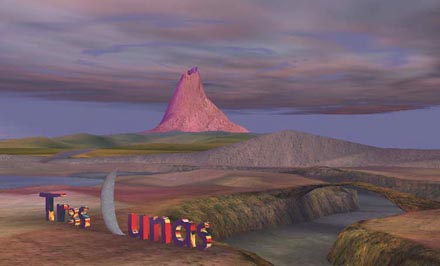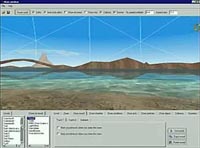|


| Around the beginning of 2000, Mike announced that he would be taking a break from recording albums, to spend time working on his virtual reality project, Music VR. He assembled a small team of people to help him turn his ideas into something that could be experienced by a wide audience. In order to find out a little of what went on behind the scenes, I spoke to one of those people, programmer Colin Dooley. |
| |
Colin Dooley has been programming for the best part of two decades. He began while still at school and went on to program games for home computers during the 1980s. He then moved on to writing CAD software and 3D editors for Silicon Graphics computers, which is how he became involved with Music VR.
"A few years ago Mike did a prototype Music VR on a big SGI workstation. He used one of my programs to create the graphics, so that's when I first met him. After that we sort of kept in touch, Mike would call me every once in a while to ask if I thought a normal PC was up to the job yet. Eventually I said yes, I thought it was and that's when we started work."
That was two years ago. Since then, Music VR has gone from its beginnings on a computer the size of a large filing cabinet (with a price nearer that of an entire office...) to something that can be played at home on the average Windows PC. |
| |

Graphic artist Nick Catcheside at work
|
|
Music VR for the PC was written from the ground up, meaning a lot of programming work had to go into it initially. There was also a steep learning curve involved for Colin, as although he was experienced in the creation of 3D software, Music VR was his first 3D game.
"I knew OpenGL from the CAD work but there's been an awful lot of other things to learn to be able to write a PC game. Sound was a big headache, it's nowhere near as easy as it looks. This was also my first program written in C++, I'd always worked in C before."
"C++ is quite a nasty language, full of pitfalls, but I'd been doing some Java programming just before we started the project and I saw that Object Oriented programming was the way forward. Java doesn't cut the mustard for 3D games so I had to grit my teeth and learn C++." |
|
Colin's background in 3D editing software was to be called on more directly when it came to putting together the 3D world of Music VR.
"For the graphics we used a 3D editor I wrote a few years ago, along with photoshop and 3D Studio. 3D Studio is great for making videos but not so hot for games. The little 3D editor is good at fiddling with polygons and applying textures and materials so that's what we used to put the world together. I suspect it was strained to the limit, but it held up like a trooper."
|
More editing software of Colin's was brought in to play, in order to allow Mike to assemble the many elements that make up the Music VR environment.
"I had to write a custom 3D editor to bring everything together, so Mike could take the 3D world and add sound and extra control information to it. The control information is what triggers events, lets you pick up rings, etc."
"I've really tried to stay out of the way and let Mike decide what goes into the game. Occasionally I've had to draw the line when something was impossible to do, or would take too long to implement. One of the great things about working with somebody who doesn't know much about computers or video games is that they don't have preconceived ideas about what a game should be, you end up with something really different. I've really tried to let Mike do all the design himself, with occasional proddings when I could see a much better way of doing things."
|
|

The editing software used to create the Music VR environment
|
|
|

Mike in his studio with Music VR, the editing software visible.
|
|
Of course, a central part of the game is the music, an area in which Mike's talents are well known. Did Colin notice anything interesting about the way that Mike worked?
"What's really surprised me is the amount of rewrites he does. He'll do loads of different versions of a track until he's happy with it. He's really fast too, at one point the game music seemed to change on a daily basis."
Some of the evolution of the music can be traced by comparing the early Music VR audio samples (which were available on the net) to the music in the finished game. It's also interesting to compare the music in the game to the music on the album, to hear how Mike has added parts to give the music more interest without the visuals. Indeed, Mike feels that the album music doesn't work with the game, as there's too much going on in it. |
|
On seeing the credits for the game, some may be surprised to see that the whole thing was put together by only three people (Mike, Colin and graphic artist Nick Catcheside). There were good reasons for this, as Colin explained:
"We made a decision early on that we weren't trying to compete with the top ten games because that needs a huge infrastructure, it's almost like making a Hollywood movie these days - maybe 30 to 50 people working on a project for three or four years. We couldn't do that - setting up a big company like that and finding the right people for a big team isn't easy. I think [that having a small team] was an advantage because the development has been fairly informal. We had fun doing it, we didn't have to turn into managers. I'm sure that if we'd made a big team we'd have spent more time managing than working."
The big question now is...are there more projects to come from Oldfield Interactive Ltd?
"That depends on Mike, though I'm pretty sure we'll do another one if it's a success."
More information on Music VR can be found at www.mikeoldfield.com
Many thanks to Colin Dooley for his time. Thanks also to Tim Unwin for brainstorming assistance.
© Richard Carter 2002
Back to Tres Lunas page
|
|
|